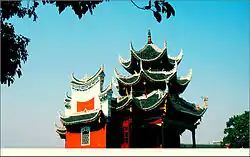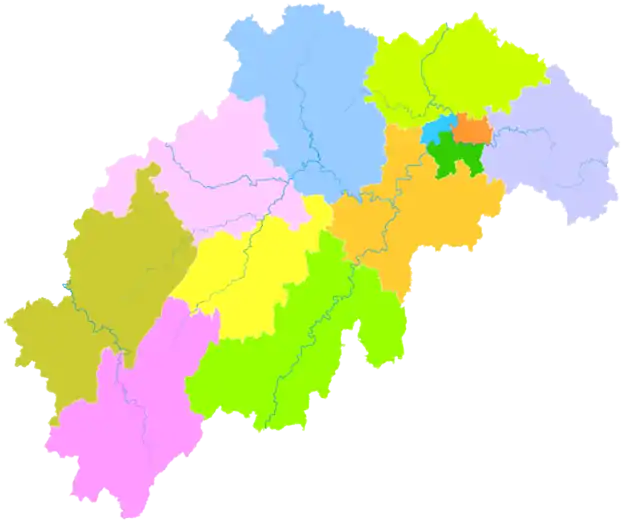Shaoyang
Shaoyang (simplified Chinese: 邵阳; traditional Chinese: 邵陽; pinyin: Shàoyáng), formerly named Baoqing (Paoking) (Chinese: 宝庆), is a prefecture-level city in southwestern Hunan province, China, bordering Guangxi to the south. It has a history of 2500 years and remains an important commercial and transportation city in Hunan. It has a city area and eight suburban counties, with a population of 7.6 million, the largest in Hunan province.
Shaoyang
邵阳市 Paoking | |
|---|---|
 The River God Temple (水府庙) | |
.png.webp) Location of Shaoyang City jurisdiction in Hunan | |
 Shaoyang Location of the city centre in Hunan | |
| Coordinates (Shaoyang municipal government): 27°14′22″N 111°28′04″E | |
| Country | People's Republic of China |
| Province | Hunan |
| County-level divisions |
|
| Township-level divisions |
|
| Village-level divisions |
|
| Municipal seat | Daxiang District |
| Area | |
| • Prefecture-level city | 20,829.63 km2 (8,042.37 sq mi) |
| • Urban (2017)[1] | 83.00 km2 (32.05 sq mi) |
| • Districts[1] | 436.0 km2 (168.3 sq mi) |
| Population (2010) | |
| • Prefecture-level city | 7,071,741 |
| • Density | 340/km2 (880/sq mi) |
| • Urban (2017)[1] | 679,599 |
| • Districts[1] | 838,000 |
| Time zone | UTC+8 (China Standard) |
| Postal code | 422000 |
| Area code(s) | 0739 |
| ISO 3166 code | CN-HN-05 |
| Licence plate prefixes | 湘E |
| Administrative division code | 430500 |
One of the major forest areas in Hunan, Shaoyang has a forest coverage of 42.7%. The 23,000,000 acres (93,000 km2) NanShan Pastures is one of the biggest in Southern China which provide dairy products and meat for Hunanese.
Shaoyang is home to Shaoyang University. The school is composed of former Shaoyang Normal College and Shaoyang College.
The Shaoyang dialect of Lou Shao group of dialects of Xiang is generally spoken here.
Climate
Shaoyang has a monsoon-influenced, four-season humid subtropical climate (Köppen Cfa), with cool, damp winters, and hot, humid summers. Winter begins relatively dry but not sunny and becomes progressively damper and cloudier; spring brings both the most frequent and heaviest rain of the year. Summer is comparatively sunny, while autumn is somewhat dry. The monthly 24-hour average temperatures ranges from 5.2 °C (41.4 °F) in January to 28.2 °C (82.8 °F) in July, while the annual mean is 17.05 °C (62.7 °F). The annual precipitation is about 1,340 mm (53 in).
| Climate data for Shaoyang (1971−2000) | |||||||||||||
|---|---|---|---|---|---|---|---|---|---|---|---|---|---|
| Month | Jan | Feb | Mar | Apr | May | Jun | Jul | Aug | Sep | Oct | Nov | Dec | Year |
| Record high °C (°F) | 24.3 (75.7) |
28.9 (84.0) |
35.9 (96.6) |
34.5 (94.1) |
36.2 (97.2) |
37.4 (99.3) |
39.5 (103.1) |
38.6 (101.5) |
37.1 (98.8) |
35.3 (95.5) |
33.0 (91.4) |
24.6 (76.3) |
39.5 (103.1) |
| Average high °C (°F) | 8.7 (47.7) |
10.2 (50.4) |
14.4 (57.9) |
21.1 (70.0) |
26.0 (78.8) |
29.4 (84.9) |
32.8 (91.0) |
32.4 (90.3) |
28.3 (82.9) |
23.0 (73.4) |
17.4 (63.3) |
12.1 (53.8) |
21.3 (70.4) |
| Daily mean °C (°F) | 5.2 (41.4) |
6.7 (44.1) |
10.7 (51.3) |
16.9 (62.4) |
21.6 (70.9) |
25.2 (77.4) |
28.2 (82.8) |
27.6 (81.7) |
23.7 (74.7) |
18.3 (64.9) |
12.8 (55.0) |
7.7 (45.9) |
17.1 (62.7) |
| Average low °C (°F) | 2.6 (36.7) |
4.3 (39.7) |
7.9 (46.2) |
13.7 (56.7) |
18.3 (64.9) |
22.0 (71.6) |
24.4 (75.9) |
24.1 (75.4) |
20.3 (68.5) |
14.9 (58.8) |
9.4 (48.9) |
4.5 (40.1) |
13.9 (57.0) |
| Record low °C (°F) | −10.5 (13.1) |
−6.0 (21.2) |
−0.6 (30.9) |
2.2 (36.0) |
9.6 (49.3) |
14.1 (57.4) |
18.1 (64.6) |
18.5 (65.3) |
12.2 (54.0) |
3.2 (37.8) |
−1.6 (29.1) |
−6.9 (19.6) |
−10.5 (13.1) |
| Average precipitation mm (inches) | 67.5 (2.66) |
82.8 (3.26) |
118.4 (4.66) |
166.2 (6.54) |
198.7 (7.82) |
200.4 (7.89) |
125.4 (4.94) |
124.3 (4.89) |
79.6 (3.13) |
87.7 (3.45) |
59.6 (2.35) |
33.8 (1.33) |
1,344.4 (52.92) |
| Average precipitation days (≥ 0.1 mm) | 15.3 | 15.3 | 18.6 | 17.8 | 16.9 | 15.2 | 11.4 | 11.6 | 8.8 | 11.7 | 10.1 | 9.6 | 162.3 |
| Source: Weather China | |||||||||||||
Administrative divisions

Shaoyang administers three districts, two county-level cities, six counties, and one autonomous county.
Districts:
- Shuangqing District (双清区)
- Daxiang District (大祥区)
- Beita District (北塔区)
County-level City:
- Wugang City (武冈市)
- Shaodong city (邵东市)
Counties:
- Shaoyang County (邵阳县)
- Xinshao County (新邵县)
- Longhui County (隆回县)
- Dongkou County (洞口县)
- Suining County (绥宁县)
- Xinning County (新宁县)
Autonomous county:
- Chengbu Miao Autonomous County (城步苗族自治县)
| Map |
|---|
Demographics
According to the Sixth National Census in 2010, Shaoyang's permanent residence population of 7,071,741 ranked it 2nd out of 14 prefecture-level divisions of Hunan; the male-female ratio was 107.95 to 100. Educational attainment levels were as follows: 4.49% bachelor's or higher, 60.01% middle school (初中) or higher, and the illiteracy rate was 3.24%. There were 1,950,605 households in which 6,913,913 resided, forming 97.77% of the provincial population and resulting in an average of 3.54 persons/household. Age distribution was as follows: 1,512,664 (21.39%) ≤14 years, 4,862,468 (68.76%) 15−64 years, 696,609 (9.85%) 65+ years.
| Division | Area[2] (km2) |
Permanent residents[3] (2010 Census) |
Hukou permits[4] (late 2009) |
Divisions[5] | |||||
|---|---|---|---|---|---|---|---|---|---|
| Subdistricts | Towns | Townships | Including ethnic townships |
Residential communities |
Villages | ||||
| SHAOYANG CITY | 20,829.63 | 7,071,741 | 7,705,957 | 21 | 97 | 99 | 21 | 335 | 5551 |
| Shuangqing District | 137.08 | 307,980 | 270,458 | 6 | 2 | 4 | 54 | 63 | |
| Daxiang District | 214.66 | 340,605 | 309,752 | 6 | 2 | 4 | 44 | 81 | |
| Beita District | 84.39 | 104,609 | 87,714 | 2 | 3 | 14 | 40 | ||
| Shaodong city | 1,776.38 | 896,625 | 1,260,966 | 3 | 16 | 9 | 33 | 977 | |
| Xinshao County | 1,762.97 | 743,073 | 764,905 | 11 | 4 | 28 | 652 | ||
| Shaoyang County | 1,996.88 | 915,600 | 999,148 | 12 | 10 | 23 | 633 | ||
| Longhui County | 2,871.16 | 1,095,392 | 1,156,917 | 15 | 11 | 2 | 41 | 964 | |
| Dongkou County | 2184.01 | 770,473 | 833,003 | 10 | 12 | 3 | 23 | 566 | |
| Suining County | 2,898.89 | 351,139 | 363,740 | 6 | 19 | 14 | 14 | 348 | |
| Xinning County | 2,751.31 | 560,742 | 607,055 | 9 | 9 | 2 | 15 | 474 | |
| Chengbu Miao Autonomous County | 2,619.76 | 250,633 | 267,921 | 6 | 5 | 21 | 271 | ||
| Wugang City | 1,532.15 | 734,870 | 784,378 | 4 | 8 | 9 | 25 | 482 | |
Government
The current CPC Party Secretary of Shaoyang is Gong Congmi and the current Mayor is Liu Shiqing.
Transportation
Railway
Shaoyang has four main railway station: Shaoyang Railway Station (邵阳火车站) (Fast Train, K and Highspeed train, G), Shaoyang Railway Station (邵阳北老火车站) (Old, North, Freight), Shaodong railway station (Fast Train, K and Highspeed train, G) and Shaoyang North railway station, in Xinshao County (Highspeed train, G and D). The Loudi–Shaoyang railway and Shanghai–Kunming high-speed railway pass through Shaoyang.
Airport
Shaoyang Wugang Airport was opened on 28 June 2017.[6] It is located 9 kilometres (5.6 mi) north of Wugang, a county-level city under the administration of Shaoyang, and 100 kilometres (62 mi) from the urban center of Shaoyang.[6]
The airport has a 2,600-meter runway and a 3,000-square-meter terminal building. It is projected to handle 250,000 passengers and 500 tons of cargo annually by 2020.[7]
Economy
| Division | RMB | USD | Purchasing power (USD) | Growth (%) | Percentage (%) | Per capita GDP |
|---|---|---|---|---|---|---|
| SHAOYANG CITY | 90,723 | 14,046 | 21,740 | 13.2 | 100 | 12,797 |
| City proper | 18,308 | 2,835 | 4,387 | 20.18 | ||
| Shuangqing District | 8,175.09 | 1,265.73 | 1,959.00 | 12.6 | 9.01 | |
| Daxiang District | 8,063.65 | 1,248.47 | 1,932.29 | 15.2 | 8.89 | |
| Beita District | 2,069.27 | 320.38 | 495.86 | 15.1 | 2.28 | 19,698 |
| Outlying | 76,358 | 11,822 | 18,298 | 84.17 | ||
| Shaodong County | 20,220.00 | 3,130.61 | 4,845.32 | 14.4 | 22.29 | 22,299 |
| Xinshao County | 7,429.81 | 1,150.34 | 1,780.41 | 13.6 | 8.19 | 9,998 |
| Shaoyang County | 8,108.55 | 1,255.43 | 1,943.05 | 12.2 | 8.94 | 7,796 |
| Longhui County | 9,332.00 | 1,444.85 | 2,236.23 | 11.6 | 10.29 | 8,499 |
| Dongkou County | 9,012.00 | 1,395.31 | 2,159.55 | 12.6 | 9.93 | 11,784 |
| Suining County | 5,018.45 | 776.99 | 1,202.57 | 12.2 | 5.53 | |
| Xinning County | 5,307.47 | 821.74 | 1,271.83 | 11.7 | 5.85 | 9,425 |
| Chengbu County | 2,320.63 | 359.30 | 556.09 | 11.5 | 2.56 | 9,238 |
| Wugang City | 7,932.57 | 1,228.18 | 1,900.88 | 13.8 | 8.74 | 10,746 |
Although it is, by 2010 Census permanent resident population, the second-largest prefecture-level division of Hunan, its GDP (4.62% of provincial output) places it ninth within the province, making it an archetypal example of a large-population, relatively backwards-economy city. The GDP per capita of 12,797 CNY is the lowest in the province, and is only 42.9% of the provincial average, 36.5% of the national average, and 78% of even Guizhou's corresponding figure.[8] Primary, secondary, and tertiary sectors respectively accounted for 23.9%, 38.2%, and 37.9% of the economy.
Noted residents
- Tsiang Tingfu, historian and diplomat
- Wei Yuan, late Qing scholar
- He Luting, composer
- Cai E, revolutionary leader
- Liao Yaoxiang, high-ranking Kuomintang general in World War II
- Li Wangyang, labour rights activist whose "suicide" was allegedly staged by the local police
- Dr George H Pearson, founder and manager of Shaoyang Hospital from 1920 to 1951[9]
- Justin Hill, English author, whose novel, The Drink and Dream Teahouse was set in Shaoyang, and subsequently banned in China [10]
Twin cities
 Saratov, Russia
Saratov, Russia
References
- Ministry of Housing and Urban-Rural Development, ed. (2019). China Urban Construction Statistical Yearbook 2017. Beijing: China Statistics Press. p. 68. Retrieved 11 January 2020.
- 《邵阳市土地利用总体规划(2006-2020年)》
- 《邵阳市2010年第六次全国人口普查主要数据公报》
- 《中华人民共和国全国分县市人口统计资料2009》
- 《中国民政统计年鉴2011》
- 武冈机场通航,邵阳新添空中走廊. Sina. 29 June 2017.
- 新建湖南邵阳武冈机场获批复 投资9.57亿元 (in Chinese). Carnoc. 2013-08-09. Retrieved 2013-08-16.
- 2011年度各区县市统计公报. Shaoyang Statistical Bureau. Archived 2009-01-06 at the Wayback Machine). 2011 conversion from CNY to USD according to the-then exchange rate of 6.4588 CNY/1 USD, purchasing power based on an April 2012 report that used an exchange rate of 4.1731 CNY/1Geary–Khamis dollar (Intl. $).
- Pearson, George. "Snapshots of China: Shaoyang Hospital, Hunan (1946)". Youtube. BFI National Archive. Retrieved 16 October 2020.
- Council, British. "Justin Hill". British Council. British Council. Retrieved 16 October 2020.
